Zhengding Luo
DOA Estimation with Lightweight Network on LLM-Aided Simulated Acoustic Scenes
Nov 11, 2025Abstract:Direction-of-Arrival (DOA) estimation is critical in spatial audio and acoustic signal processing, with wide-ranging applications in real-world. Most existing DOA models are trained on synthetic data by convolving clean speech with room impulse responses (RIRs), which limits their generalizability due to constrained acoustic diversity. In this paper, we revisit DOA estimation using a recently introduced dataset constructed with the assistance of large language models (LLMs), which provides more realistic and diverse spatial audio scenes. We benchmark several representative neural-based DOA methods on this dataset and propose LightDOA, a lightweight DOA estimation model based on depthwise separable convolutions, specifically designed for mutil-channel input in varying environments. Experimental results show that LightDOA achieves satisfactory accuracy and robustness across various acoustic scenes while maintaining low computational complexity. This study not only highlights the potential of spatial audio synthesized with the assistance of LLMs in advancing robust and efficient DOA estimation research, but also highlights LightDOA as efficient solution for resource-constrained applications.
Self-Boosted Weight-Constrained FxLMS: A Robustness Distributed Active Noise Control Algorithm Without Internode Communication
Jul 16, 2025Abstract:Compared to the conventional centralized multichannel active noise control (MCANC) algorithm, which requires substantial computational resources, decentralized approaches exhibit higher computational efficiency but typically result in inferior noise reduction performance. To enhance performance, distributed ANC methods have been introduced, enabling information exchange among ANC nodes; however, the resulting communication latency often compromises system stability. To overcome these limitations, we propose a self-boosted weight-constrained filtered-reference least mean square (SB-WCFxLMS) algorithm for the distributed MCANC system without internode communication. The WCFxLMS algorithm is specifically designed to mitigate divergence issues caused by the internode cross-talk effect. The self-boosted strategy lets each ANC node independently adapt its constraint parameters based on its local noise reduction performance, thus ensuring effective noise cancellation without the need for inter-node communication. With the assistance of this mechanism, this approach significantly reduces both computational complexity and communication overhead. Numerical simulations employing real acoustic paths and compressor noise validate the effectiveness and robustness of the proposed system. The results demonstrate that our proposed method achieves satisfactory noise cancellation performance with minimal resource requirements.
Exploration by Random Reward Perturbation
Jun 10, 2025Abstract:We introduce Random Reward Perturbation (RRP), a novel exploration strategy for reinforcement learning (RL). Our theoretical analyses demonstrate that adding zero-mean noise to environmental rewards effectively enhances policy diversity during training, thereby expanding the range of exploration. RRP is fully compatible with the action-perturbation-based exploration strategies, such as $\epsilon$-greedy, stochastic policies, and entropy regularization, providing additive improvements to exploration effects. It is general, lightweight, and can be integrated into existing RL algorithms with minimal implementation effort and negligible computational overhead. RRP establishes a theoretical connection between reward shaping and noise-driven exploration, highlighting their complementary potential. Experiments show that RRP significantly boosts the performance of Proximal Policy Optimization and Soft Actor-Critic, achieving higher sample efficiency and escaping local optima across various tasks, under both sparse and dense reward scenarios.
Preventing output saturation in active noise control: An output-constrained Kalman filter approach
Dec 25, 2024Abstract:The Kalman filter (KF)-based active noise control (ANC) system demonstrates superior tracking and faster convergence compared to the least mean square (LMS) method, particularly in dynamic noise cancellation scenarios. However, in environments with extremely high noise levels, the power of the control signal can exceed the system's rated output power due to hardware limitations, leading to output saturation and subsequent non-linearity. To mitigate this issue, a modified KF with an output constraint is proposed. In this approach, the disturbance treated as an measurement is re-scaled by a constraint factor, which is determined by the system's rated power, the secondary path gain, and the disturbance power. As a result, the output power of the system, i.e. the control signal, is indirectly constrained within the maximum output of the system, ensuring stability. Simulation results indicate that the proposed algorithm not only achieves rapid suppression of dynamic noise but also effectively prevents non-linearity due to output saturation, highlighting its practical significance.
Transferable Selective Virtual Sensing Active Noise Control Technique Based on Metric Learning
Sep 09, 2024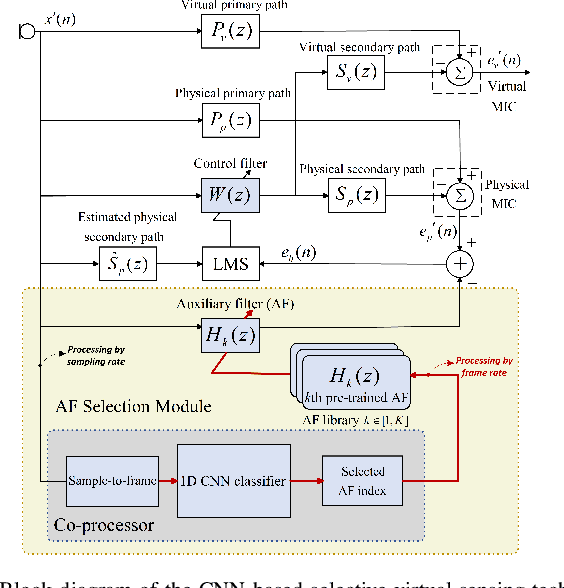
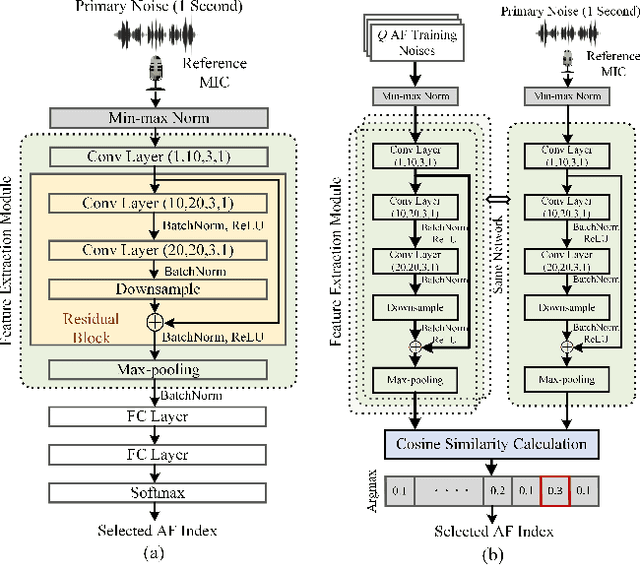
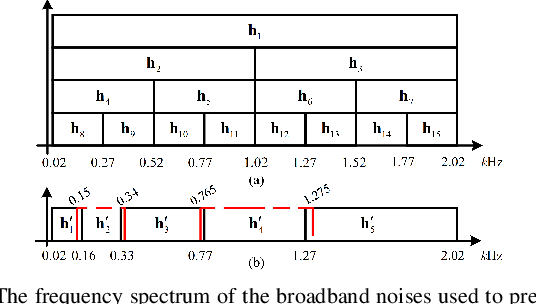
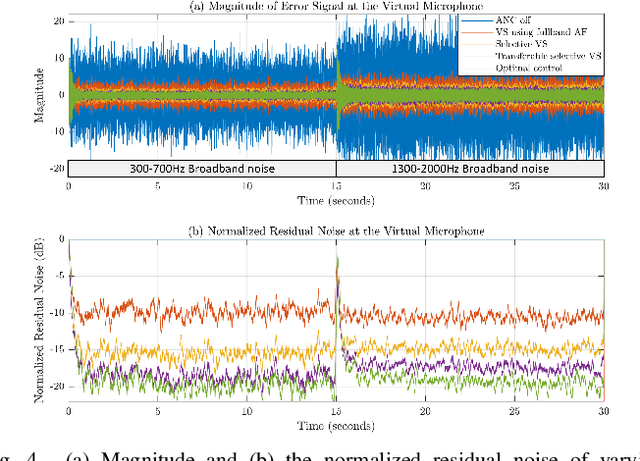
Abstract:Virtual sensing (VS) technology enables active noise control (ANC) systems to attenuate noise at virtual locations distant from the physical error microphones. Appropriate auxiliary filters (AF) can significantly enhance the effectiveness of VS approaches. The selection of appropriate AF for various types of noise can be automatically achieved using convolutional neural networks (CNNs). However, training the CNN model for different ANC systems is often labour-intensive and time-consuming. To tackle this problem, we propose a novel method, Transferable Selective VS, by integrating metric-learning technology into CNN-based VS approaches. The Transferable Selective VS method allows a pre-trained CNN to be applied directly to new ANC systems without requiring retraining, and it can handle unseen noise types. Numerical simulations demonstrate the effectiveness of the proposed method in attenuating sudden-varying broadband noises and real-world noises.
Knowledge Sharing and Transfer via Centralized Reward Agent for Multi-Task Reinforcement Learning
Aug 20, 2024Abstract:Reward shaping is effective in addressing the sparse-reward challenge in reinforcement learning by providing immediate feedback through auxiliary informative rewards. Based on the reward shaping strategy, we propose a novel multi-task reinforcement learning framework, that integrates a centralized reward agent (CRA) and multiple distributed policy agents. The CRA functions as a knowledge pool, which aims to distill knowledge from various tasks and distribute it to individual policy agents to improve learning efficiency. Specifically, the shaped rewards serve as a straightforward metric to encode knowledge. This framework not only enhances knowledge sharing across established tasks but also adapts to new tasks by transferring valuable reward signals. We validate the proposed method on both discrete and continuous domains, demonstrating its robustness in multi-task sparse-reward settings and its effective transferability to unseen tasks.
Highly Efficient Self-Adaptive Reward Shaping for Reinforcement Learning
Aug 07, 2024Abstract:Reward shaping addresses the challenge of sparse rewards in reinforcement learning by constructing denser and more informative reward signals. To achieve self-adaptive and highly efficient reward shaping, we propose a novel method that incorporates success rates derived from historical experiences into shaped rewards. Our approach utilizes success rates sampled from Beta distributions, which dynamically evolve from uncertain to reliable values as more data is collected. Initially, the self-adaptive success rates exhibit more randomness to encourage exploration. Over time, they become more certain to enhance exploitation, thus achieving a better balance between exploration and exploitation. We employ Kernel Density Estimation (KDE) combined with Random Fourier Features (RFF) to derive the Beta distributions, resulting in a computationally efficient implementation in high-dimensional continuous state spaces. This method provides a non-parametric and learning-free approach. The proposed method is evaluated on a wide range of continuous control tasks with sparse and delayed rewards, demonstrating significant improvements in sample efficiency and convergence stability compared to relevant baselines.
A Survey of Integrating Wireless Technology into Active Noise Control
May 21, 2024



Abstract:Active Noise Control (ANC) is a widely adopted technology for reducing environmental noise across various scenarios. This paper focuses on enhancing noise reduction performance, particularly through the refinement of signal quality fed into ANC systems. We discuss the main wireless technique integrated into the ANC system, equipped with some innovative algorithms, in diverse environments. Instead of using microphone arrays, which increase the computation complexity of the ANC system, to isolate multiple noise sources to improve noise reduction performance, the application of the wireless technique avoids extra computation demand. Wireless transmissions of reference, error, and control signals are also applied to improve the convergence performance of the ANC system. Furthermore, this paper lists some wireless ANC applications, such as earbuds, headphones, windows, and headrests, underscoring their adaptability and efficiency in various settings.
Unsupervised learning based end-to-end delayless generative fixed-filter active noise control
Feb 08, 2024



Abstract:Delayless noise control is achieved by our earlier generative fixed-filter active noise control (GFANC) framework through efficient coordination between the co-processor and real-time controller. However, the one-dimensional convolutional neural network (1D CNN) in the co-processor requires initial training using labelled noise datasets. Labelling noise data can be resource-intensive and may introduce some biases. In this paper, we propose an unsupervised-GFANC approach to simplify the 1D CNN training process and enhance its practicality. During training, the co-processor and real-time controller are integrated into an end-to-end differentiable ANC system. This enables us to use the accumulated squared error signal as the loss for training the 1D CNN. With this unsupervised learning paradigm, the unsupervised-GFANC method not only omits the labelling process but also exhibits better noise reduction performance compared to the supervised GFANC method in real noise experiments.
A Computation-efficient Online Secondary Path Modeling Technique for Modified FXLMS Algorithm
Jun 20, 2023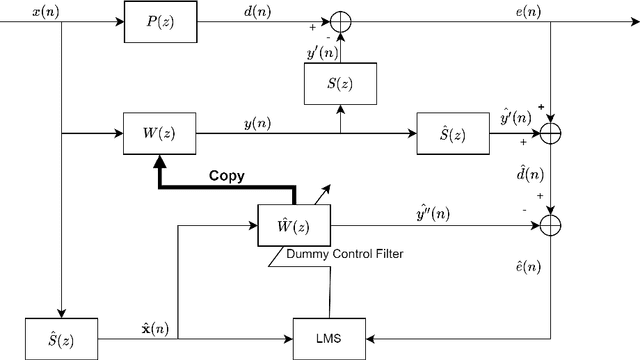
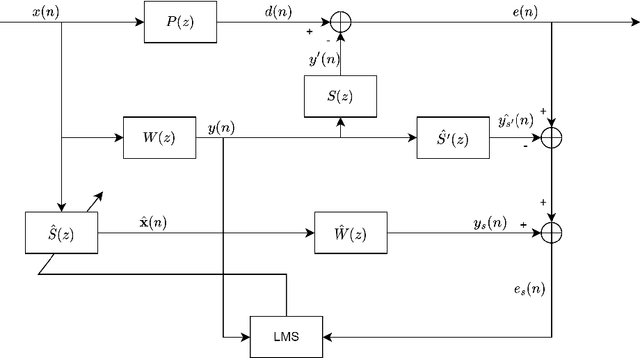

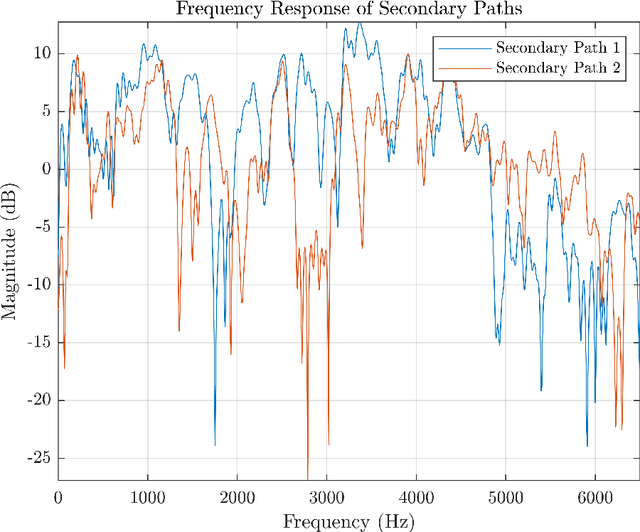
Abstract:This paper proposes an online secondary path modelling (SPM) technique to improve the performance of the modified filtered reference Least Mean Square (FXLMS) algorithm. It can effectively respond to a time-varying secondary path, which refers to the path from a secondary source to an error sensor. Unlike traditional methods, the proposed approach switches modes between adaptive ANC and online SPM, eliminating the use of destabilizing components such as auxiliary white noise or additional filters, which can negatively impact the complexity, stability, and noise reduction performance of the ANC system. The system operates in adaptive ANC mode until divergence is detected due to secondary path changes. At this moment, it switches to SPM mode until the path is remodeled and then returns to ANC mode. Furthermore, numerical simulations in the paper demonstrate that the proposed online technique effectively copes with the secondary path variations.
 Add to Chrome
Add to Chrome Add to Firefox
Add to Firefox Add to Edge
Add to Edge